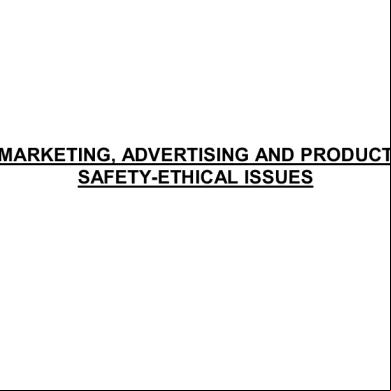Ethical Issues In Marketing And Advertising 4n1g4p
This document was ed by and they confirmed that they have the permission to share it. If you are author or own the copyright of this book, please report to us by using this report form. Report 2z6p3t
Overview 5o1f4z
& View Ethical Issues In Marketing And Advertising as PDF for free.
More details 6z3438
- Words: 1,700
- Pages: 42
|
! " # | | $
|
‡ Ethics in marketing ± focuses on the ensuring ethical practices in the methods of marketing and selling the products to the consumers. ± Seeks to ensure fairness and transparency in marketing.
|
|
Î
‡ Unethical marketing practices of businesses. ‡ E.g.:-cigarette companies reducing menthol levels to hook first- time smokers.
‡ Focus on increasing revenues at any cost. ‡ Leading to exploitation of consumers. ‡ Defective products being marketed to them. ‡ Harmful effects of the products like:- health hazards, other damages.
|
| %
‡ People who buy and use products with the intention of fulfilling their needs are called consumers. ‡ The idea of consumer protection ± is to protect the consumers from the damages caused to them, ± by giving them correct and complete information ± In other words, to develop a sense of moral duty & responsibility on the part of business organizations. |
|
‡ The purpose of a business is to create customers for its products and services. ‡ They a business. ‡ It will result in the well- being of the company.
|
|
Î Î
|
| &
|
| '
Î ‡ a e.g. honesty, autonomy, privacy, transparency. ‡ e.g. consumers, competitors, society as a whole ‡ e.g. research, price, promotion, placement |
| #
|
|
‡ Sales practices - pressure on sales personnel to sell ‡ Violating ways - deception - manipulation |
|
‡ Labeling: means for selling product & also informing the consumer. - Fair Packaging and Labeling Act ed by congress in 1966 - Nutrition Labeling and Education Act (NLEA) (1990) |
|
‡ î : ethical danger points in marketing research include: - Invasion of privacy - Stereotyping ‡ î : ethical danger points include - Targeting the vulnerable e.g. children, the elderly - Excluding potential customers from the market: |
|
‡ : Process of determining what a company will receive in exchange for its product ‡ The moral (and legal) issues in pricing fall into two categories: ---The use of prices to engage in anticompetitive behavior that can seriously harm other firms. ---Concerns fairness in pricing , which can be violated when prices are used to deceive or manipulate consumers and when goods are overpriced in ways that | consumers cannot easily detect.
| %
The major anticompetitive marketing practices are as follows: ‡ Is an agreement , either explicit or implicit, among two or more companies in the same market to sell goods at a set price. ‡ Products are sold on the condition that they be resold at a price fixed by the manufacturer or distributor. ‡ Charging of different prices or offering different of sale for goods of the same kind to different buyers. ‡ Reducing prices to unreasonably low or unprofitable levels in order to drive competitors | out of business.
|
Pricing can be done in ways that treat consumers unfairly The main type of such unfair pricing are : ‡ Unconscionably high price (price gouging) ‡ Misleading prices, including prices that are difficult to determine and compare.
|
|
The means by which the products are delivered from the manufacturer to the ultimate consumer The main ethical issues in distribution are : ‡ to gain access to shelf space in stores ‡ «that arise from diverting and parallel importing. Three illegal abuses of power in distribution are : ‡ Reciprocal Dealing ‡ Exclusive Dealing ‡ Tying dealing |
| &
|
| '
Î ‡ Non personal communication ‡ About an organization and its products ‡ To a target audience ‡ Through a mass medium |
| #
1.Covert Advertising ± Advertising in movies
|
|
£
|
|
· Advertising in commercial ads .
Digital Video Camera 6M Pixel with MP3 / MP4 and Flashlight (Force /auto/off), Video recorder (with sound), Still Photos PC Camera and MP3 player, Digital voice recorder and Power control: Auto power off |
|
0
|
|
º
|
| %
‡ To build brand personality ‡ To increase the sales of the product/service ‡ To create and maintain a brand image. ‡ To introduce a new product or service. |
|
‡ Truthfulness in advertising ‡ To establish itself in the hearts of the customers
|
|
|
| &
‡
ment creates false belief
‡ Interferes with the ability of people to make rational consumer choices ‡ Depends not only on truth or falsity of claims but also on its impact
|
| '
|
| #
‡ ‡ ‡ ‡ ‡ ‡ ‡ ‡ ‡ ‡ ‡
Hidden fees and surcharges Rebates Inflated price comparison Cost-plus pricing Buy u, get free Introductory offers Non-sale ments Disclaimers and fine print Fillers and oversized packaging Label tampering |
|
‡ { !
‡ " ± © ±
|
| %
‡ Making use of subconscious factors that influence human actions ‡ Play on human desires for security, acceptance, self esteem, etc
|
| %
Î |
| %
‡ Interferes with freedom of choice
‡ Acts without our knowledge and thus without consent
|
| %%
Are we aware that products are being d without our consent « ???
|
| %
|
| %
J J J
! |
| %&
" " # # ! !
) !
d
" !$%&' %&'
! (
|
| %'
! * + , + * ! J . / & # & $# % & # +- # # # |
| %#
© Advertising Educates Consumers ± Pro: Advertising informs ± Con: Advertising is superficial and intrusive M()! * +
‡ Advertising improves living standards ± Pro: Ads lower the costs of products ± Con: Ads are wasteful and help only some |
| %
d - *
#
&*
d
,
0
|
|
-
|
|
|
|





